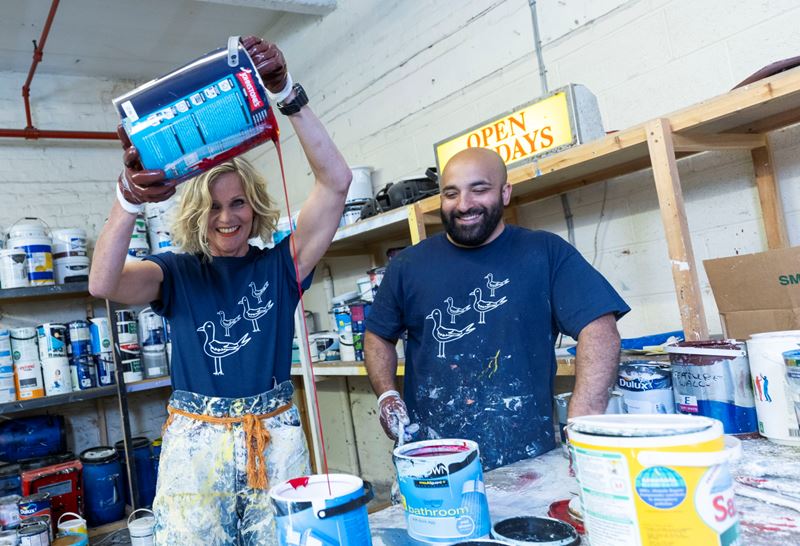UK’s paint stash totals over 50 million litres, posing environmental issues
Households across the UK are stockpiling enough paint to coat the Forth Rail Bridge 212 times, posing major sustainability and environmental issues, as revealed by our research. We’re asking consumers to write to their elected representatives to help highlight this issue.
Despite spoiling in a matter of months if stored incorrectly, 73% of UK adults have admitted to stashing away pots of unused or partially used decorating paint - 43% of which is more than three years old.
But what many may not know is paint contains hidden chemicals called polymers in liquid formulations (PLFs). These are often made from fossil sources and are important ingredients needed to help paint stick to walls. Despite containing huge quantities of these specialist ingredients created using non-renewable resources, nearly all (98%) of the UK’s waste paint is either burnt or sent to landfill.
Indeed, only just over a quarter (27%) of UK adults said they have recycled paint they no longer need and 67% don’t know if their local recycling facility will allow them to recycle decorating paint. However, 82% of those surveyed said they probably would use a recycling facility if they had confidence leftover paint could be recycled.
To help combat this issue, we are calling for UK governments to provide better support to local reuse and recycling initiatives, while the companies behind paint brands Dulux, Farrow and Ball, Johnstone’s Paints and Ronseal are calling for government engagement with the British Coatings Federation’s PaintCare blueprint for a national remanufacturing programme.
Professor Tom Welton, our President, said: “We have found that most households have tins of paint languishing in cupboards, sheds and garages – and that while consumers want to be able to recycle, they face a postcode lottery, making it unnecessarily difficult to do the right thing. All this paint contains huge quantities of valuable polymers in liquid formulations to help it stick to your walls. It’s unsustainable to waste such a commodity, and we’re risking environmental damage through not re-using and recycling, so we’re urging consumers to write to their elected representatives to help highlight this issue.
“Our research shows we are currently producing enough of these polymers to fill Wembley stadium 32 times every year and we are only just beginning to understand where they go after being used. Industry giants are supporting both the BCF’s PaintCare scheme to make paint more sustainable, and our task force to make polymers more sustainable across eight sectors – but we need government to engage with us, provide better support to circular economy initiatives and invest in a sustainable future for the UK.”

The BCF framework is predicted to increase the percentage of leftover paint re-used, recycled, or re-manufactured from 2% today to 75% by 2030 – which represents 275 million litres of leftover paint.
Our campaign was supported by celebrity decorator and TV presenter Linda Barker, who said: “Decorating was a fabulous way for us to cope with lockdowns during the pandemic, but a direct result of that is we’ve been left with an awful lot of unused paint – and while there are some organisations who offer recycling, coverage across the UK is sporadic at best.
“We all have a responsibility to be more sustainable and there is already a huge trend for making more environmentally friendly choices when buying paint, so we know there is a willingness to do this. We urgently need more facilities and ways for people to be able to recycle and reuse unwanted paint so it doesn’t go bad sitting in a shed – or end up incinerated or in landfill.”

Our survey also revealed that 47% of households in the UK redecorated in the last year, with 31% of this group saying that COVID-19 measures provided an ‘excuse’ to redecorate. In total, 73% of adults living in the UK are now storing unfinished tins of paint.
When asked why they stockpiled unused paint, 30% said it seemed a waste to just throw it away, while 73% said they were holding on to excess paint in case it was needed for touch-ups or repainting.
Tom Bowtell, Chief Executive Officer of British Coatings Federation and Chair of our Surface Coatings Group, said: “Our own research echoes that of the RSC and estimates that 55 million litres of waste decorative paint is generated in the UK each year. Our PaintCare initiative sees this left-over paint as a valuable resource and plans to recover and reuse it. Consumers and professional painters will be able to take their old paint to their local waste recycling centre or DIY outlet where it would be taken to a paint recycling factory for sorting, mixing and testing to make new paint of the highest quality for re-selling. It’s a closed loop system – paint made from paint. We will also develop sustainable ways to use paint not suitable for remanufacture into new materials such as concrete.”
Earlier this year we took a landscape view of the sustainability of ingredients found in millions of household products through our report Polymers in liquid formulations (PLFs): Opportunities for a sustainable future. The paints industry is just one of eight sectors that PLFs are key ingredients for, and each year more than 36.25 million tonnes of PLFs are used in household and industrial products, from shampoos to washing detergents. The research reports that investment in innovation, waste management and the circular economy is urgently needed to make this newly-identified group of chemicals more sustainable.
We are calling for:
- Government and local authorities to provide more support to paint recycling and reuse initiatives, such as BCF’s PaintCare programme, making it easier for consumers to recycle paints no matter where they live
- Government to directly invest in research programmes for sustainable alternatives for PLFs
- Consumers to reduce wastage of paints by buying only what they need. Find out what you can do with leftover paint here
- Consumers to write to their MP asking for change - further details can be found here
In addition to the release of our report, we convened an industry task force to plan a way forward to make PLFs more sustainable. Unilever, BASF, Crown Paints, Croda, Afton Chemical and Scott Bader are among the first to join the task force, with many other organisations across eight key industries including agriculture and cosmetics sharing their expertise.
Paint recycling case study:
One paint recycling and reuse scheme that has been successful is Seagulls Reuse in Leeds. Started by friends Cat Hyde and Kate Moree in 2002, the social enterprise collects waste paint from local households, before remixing it for sale at a low price – even recolouring for customer’s specific requirements.

They set it up after discovering the environmental harm that can come from improperly disposed paint – and that there were few options to sustainably dispose of leftover paint in the UK. Pre-COVID, they prevented 350 tonnes of leftover paint going into landfill every year.
Seagulls Reuse founder Cat Hyde said: “I don’t think awareness of paint recycling has moved much over the past 20 years. I think in Leeds, people know we’re here and there are schemes around the country that do similar things, but we need more.
“We always say, it’s better to bring in unused paint that let it go off. Even if paint has gone bad, it can be remade or recycled into other products – so please don’t just throw it in the bin.”
It costs approximately £40-50k per year for Seagulls to dispose of unusable paint and Cat says schemes like theirs must be funded to address issues with stockpiling and waste going to landfill.
“At the moment, it comes down to whether or not a local authority is prepared to pay for that waste. We’re very grateful for Leeds City Council for supporting our own scheme, but we need more initiatives like ours right across the country.”
Press office
- Tel:
- +44 (0) 20 7440 3351
- Email:
- Send us an email
